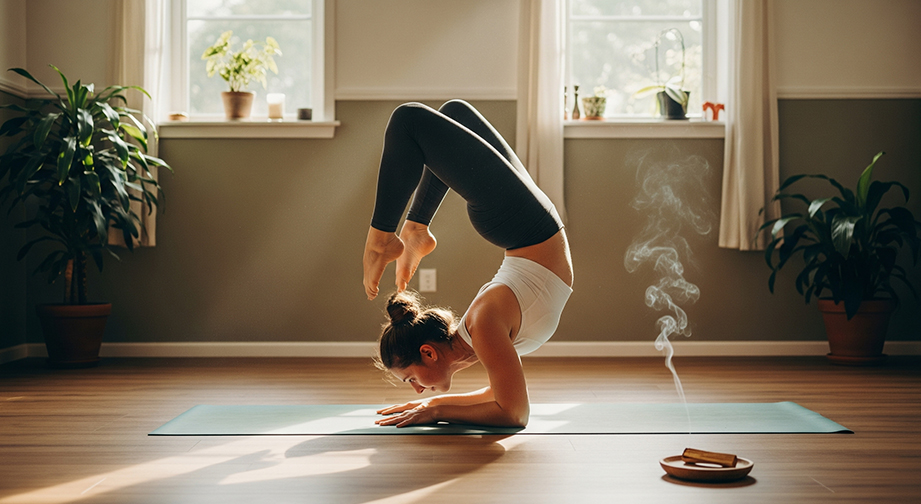Vrischikasana (Scorpion Pose): Mastering the Art of Inversion
Introduction
Vrischikasana, commonly known as Scorpion Pose, is a stunning inversion that combines balance, strength, and deep backbending. In Sanskrit, Vrischika means "scorpion," symbolizing the poised, graceful curve of a scorpion’s tail, and asana means "pose." At its core, Vrischikasana embodies energizing transformation and courage.
If you're a yogi ready to unlock new strength, channel your inner grace, and step confidently outside your comfort zone, Scorpion Pose could become your next empowering challenge!
Step-by-Step Guide to Vrischikasana (Scorpion Pose)

- Start with Forearm Plank:
Come down to your mat on your forearms, shoulder width apart. Spread your fingers wide and root down through elbows and hands.
- Move into Dolphin Pose:
Lift your hips up and walk your feet towards your chest, coming into Dolphin. Keep your gaze gently forward.
- Find Your Balance:
Bend one knee, then gently kick up, stacking hips over shoulders. Use a wall for support if you're new.
- Bend the Knees:
Once balanced, bend your knees, bringing your feet towards the head. Keep your core and back engaged.
- Next-Level Backbend (Optional):
For advanced practitioners, arch your spine further and aim to touch your toes to the back of your head. Breathe evenly.
- To Exit:
Slowly straighten your legs upward, then lower one foot at a time back to Dolphin, resting in Child’s Pose to recover.
Breathing:
- Inhale: As you kick up and lift into the inversion.
- Exhale: As you bend the knees and engage your core.
- Breathe steadily and calmly throughout the pose.
Duration: Hold for 5–8 breaths or up to 30 seconds. Repeat for up to 3 rounds, resting in between.
Modifications for Beginners:
- Practice at the wall for safety and support.
- Work on Dolphin Pose or Forearm Stand (Pincha Mayurasana) first.
- Place a block under your shoulders for extra lift and stability.
Intensifications for Advanced:
- Go deeper in the backbend, aiming to touch your head with your toes.
- Try closing the eyes to develop balance.
- Remove wall support.
Alignment & Safety Tips
- Alignment Cues:
- Press evenly through forearms and palms.
- Keep shoulders stacked directly over elbows.
- Engage core, draw ribs in, and lift through the chest.
- Gently arch through upper back, avoiding neck crunching.
- Common Mistakes:
- Overarching the lower back (protect with core engagement).
- Letting elbows splay out (keep them shoulder-width).
- Losing awareness of the neck (look forward softly, never “crane” the head).
- Safety Precautions:
- Do not practice if you have neck, shoulder, or back injuries.
- Avoid during pregnancy or with high blood pressure.
- If new to inversions, use a wall and have a spotter if possible.
Benefits of Vrischikasana (Scorpion Pose)
- Physical Benefits:
- Builds strength in shoulders, arms, and core.
- Improves flexibility through spine and hips.
- Boosts balance, posture, and body awareness.
- Mental Benefits:
- Increases concentration and focus.
- Encourages courage and helps overcome fear.
- Promotes calmness and releases stress.
- Energy / Chakra Connection:
- Stimulation of the Manipura (solar plexus) and Vishuddha (throat) chakras.
- Enhances confidence, self-expression, and personal power.
Contraindications
- People with neck, shoulder, or back injuries should avoid this pose.
- Pregnant women and those with high blood pressure or glaucoma should not practice Scorpion Pose.
- Those new to inversions—try Dolphin Pose or Sphinx Pose as a safe alternative.
Beginner’s Tips & Variations
- Use Props:
- Practice with your forearms a few inches from a wall.
- Blocks under the shoulders for extra support.
- Bolster under the chest for gentle backbend without inversion.
- Gentle Variations:
- Stay in Dolphin or Forearm Stand (Pincha Mayurasana) and focus on alignment.
- Work only on kicking up, one side at a time.
- Advanced Variations:
- Full Vrischikasana: aim toes towards head, deepen the curve.
- Try without the wall, working towards full balance, or add leg splits.
How to Include Vrischikasana in a Yoga Flow
Vrischikasana works best as a main practice or a peak pose in your routine. Warm up thoroughly first!
Pairs well with:
- Dolphin Pose (for warming up shoulders and arms)
- Upward Facing Dog (to prep the spine for backbending)
- Child’s Pose (as a gentle counterpose)
Mind-Body Connection
Practicing Scorpion Pose requires presence and patience— it invites you to move past fears and trust both your physical and mental strength. Many believe it awakens spiritual power in the solar plexus chakra, boosting willpower and perseverance.
Summary Box
Asana Name: Scorpion Pose / Vrischikasana
Level: Advanced
Focus Areas: Core, shoulders, upper back, spine
Duration: 5–30 seconds (1–3 rounds)
Best Time to Practice: Morning or early evening, on an empty stomach
Vrischikasana (Scorpion Pose) FAQs
Q: I can’t balance—what should I do?
A: Don’t worry! Use a wall, focus on Dolphin Pose, and build shoulder/core strength first.
Q: How do I avoid neck strain?
A: Always keep your gaze neutral and don’t collapse the head—press firmly through forearms.
Q: Is it normal to feel fear?
A: Absolutely! Inversions require time and mindful practice. Stay patient and be kind to yourself.
Scorpion Pose is a journey—not a race. Every effort on your mat brings new awareness and growth. Approach Vrischikasana with curiosity, respect, and a playful heart!